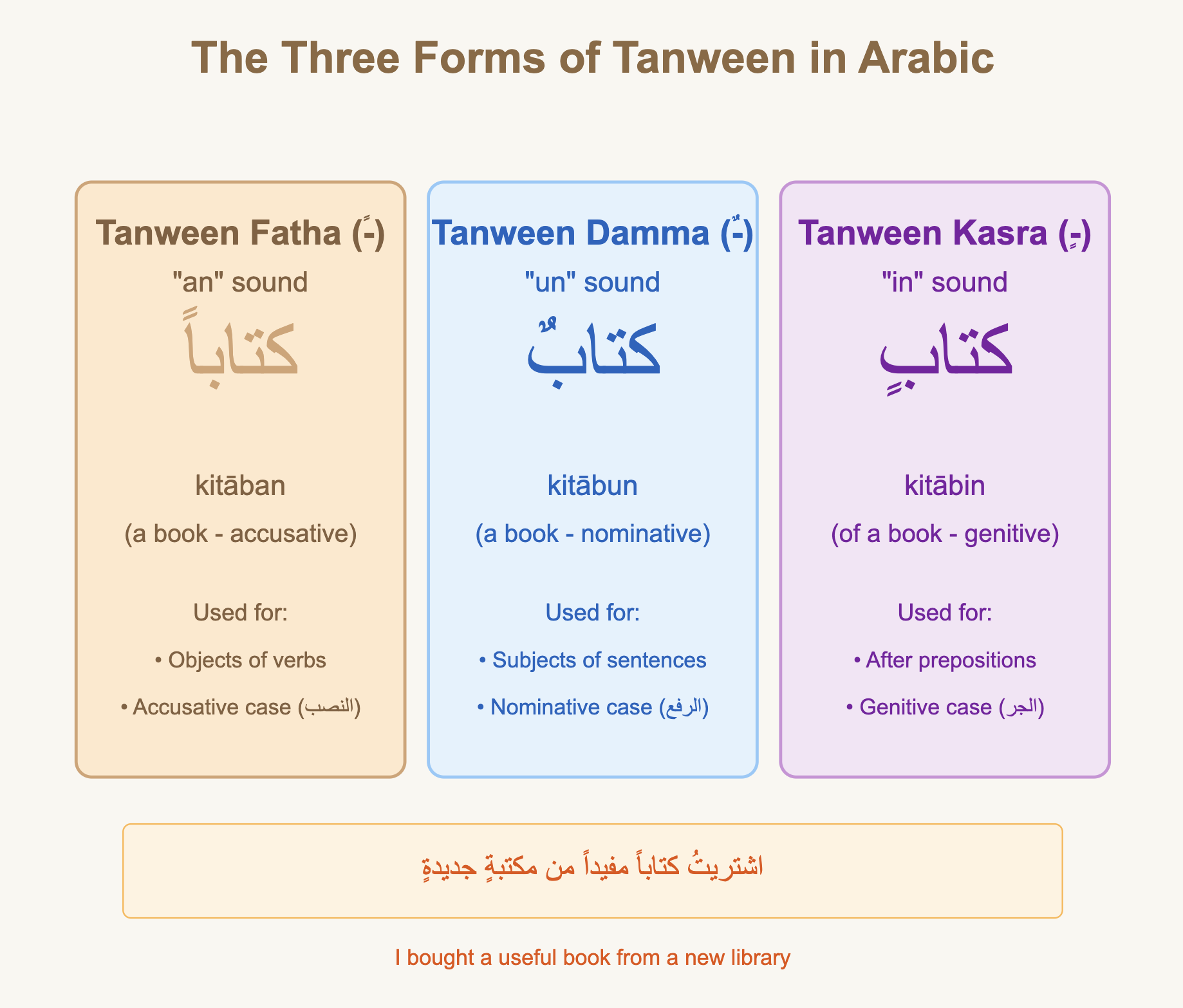
Tanween adds a beautiful rhythmic quality to Arabic pronunciation while serving essential grammatical functions. This guide will help you understand this crucial aspect of Arabic grammar.
What Is Tanween?
Tanween (تنوين) represents one of the most distinctive features of Arabic grammar. It refers to the doubling of short vowels (حركات) at the end of nouns or adjectives, creating an "n" sound that indicates indefiniteness. Think of it as Arabic's version of the indefinite article "a" or "an" in English, though its usage extends beyond this simple comparison.
Tanween appears in three elegant forms:
Tanween Fatha ( -ً- ) produces an "an" sound, as in كتاباً (kitāban) meaning "a book"
Tanween Damma ( -ٌ- ) creates an "un" sound, as in كتابٌ (kitābun) meaning "a book"
Tanween Kasra ( -ٍ- ) gives an "in" sound, as in كتابٍ (kitābin) meaning "of a book"
Each form serves specific grammatical functions within Arabic sentences, creating a harmonious structure that guides both meaning and pronunciation.

The Purpose of Tanween in Arabic Grammar
Tanween serves two primary functions that are essential for proper Arabic communication:
Marking Indefiniteness: When a noun isn't specific, we apply tanween. Consider these examples:
رأيتُ كتاباً في المكتبة
(ra'aytu kitāban fil maktabah) - "I saw a book in the library"
The book is indefinite, marked by tanween fatha
رأيتُ الكتاب في المكتبة
(ra'aytu al-kitāba fil maktabah) - "I saw the book in the library"
The book is definite because of الـ (al-), so no tanween is used
Indicating Grammatical Case: Tanween also helps express the grammatical role of words:
Tanween Fatha (-ً) marks the accusative case (حالة النصب), often used for objects of verbs
Tanween Damma (-ٌ) indicates the nominative case (حالة الرفع), typically for subjects
Tanween Kasra (-ٍ) shows the genitive case (حالة الجر), commonly following prepositions
The Rich History of Tanween
The Arabic writing system has evolved significantly throughout history. Original Arabic scripts contained no vowel marks or diacritical signs, relying entirely on context for meaning. This changed during the Islamic Golden Age when scholars recognized the need for clarity.
In the 8th century, pioneering linguists Al-Khalil ibn Ahmad al-Farahidi and Abu al-Aswad al-Du'ali introduced vowel markings (حركات) to prevent misinterpretation of the Quran. Later, Al-Laithi (الليثي) refined these systems by adding tanween and other diacritical marks.
This innovative development proved invaluable for both non-native speakers learning Arabic and native Arabs seeking to preserve precise pronunciation and meaning. Today, these marks continue to play a vital role in maintaining the integrity of Arabic texts.
Tanween in Action: Practical Examples
Let's explore how tanween functions in real Arabic sentences:
Tanween Fatha (-ً-)- Typically for Objects
اشتريتُ قلماً جديداً
(ishtaraytu qalaman jadīdan) - "I bought a new pen"
رأيتُ طائراً في الحديقة
(ra'aytu tā'iran fil hadīqah) - "I saw a bird in the garden"
Notice how tanween fatha marks the direct objects in these sentences
Tanween Damma (-ٌ-) - Often for Subjects
هذا كتابٌ مفيدٌ
(hādhā kitābun mufīdun) - "This is a useful book"
عندي قميصٌ أزرقٌ
('indī qamīsun azraqun) - "I have a blue shirt"
Here, tanween damma marks nouns in the nominative case, typically subjects
Tanween Kasra (-ٍ-) - Commonly After Prepositions
ذهبتُ إلى مسجدٍ قريبٍ
(dhahabtu ilā masjidín qarībin) - "I went to a nearby mosque"
اشتريتُ كتاباً من مكتبةٍ مشهورةٍ
(ishtaraytu kitāban min maktabatin mashhūratin) - "I bought a book from a famous library"
Tanween kasra appears here after prepositions, showing the genitive case
As you continue your Arabic language journey, pay special attention to these small but mighty markings. Notice how they shape meaning and structure in everything you read. With practice and awareness, correctly using tanween will become second nature, elevating your Arabic proficiency to new heights.
Remember: The next time you encounter -ً- , -ٌ- , or -ٍ- at the end of an Arabic word, you're witnessing a sophisticated grammatical system that has preserved meaning and pronunciation for over a thousand years!

Mahboobah is an Arabic Enrichment Centre in Mont Kiara in Kuala Lumpur, Malaysia.
Check out our on-site and online programs
Download Mahboobah Magazine For Free
